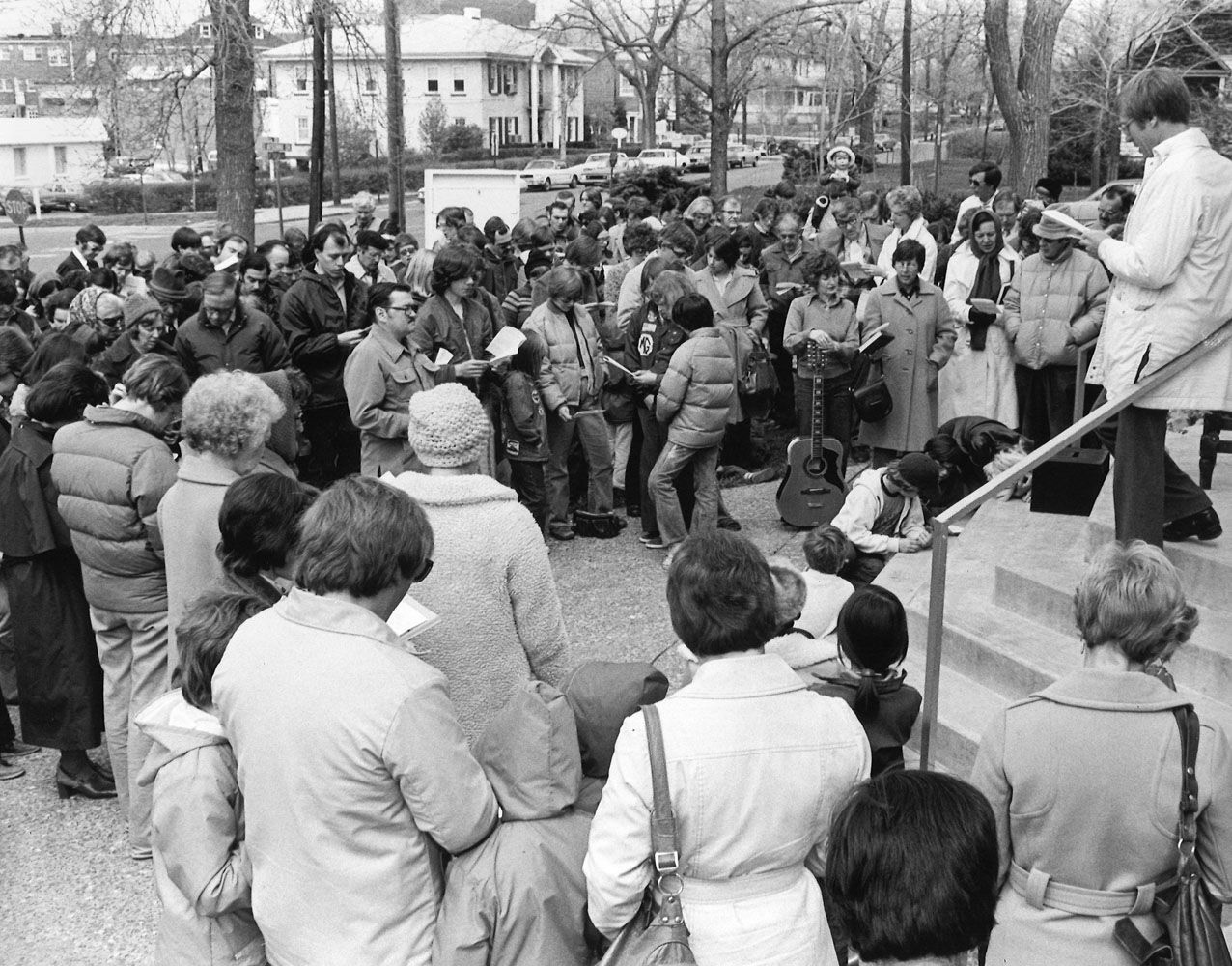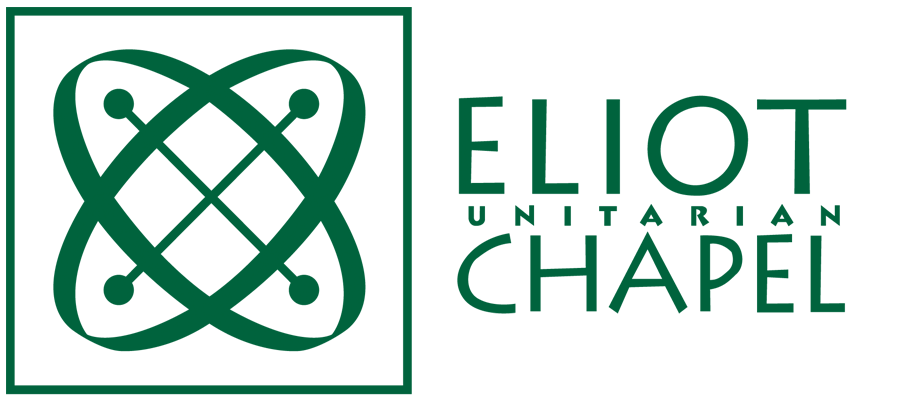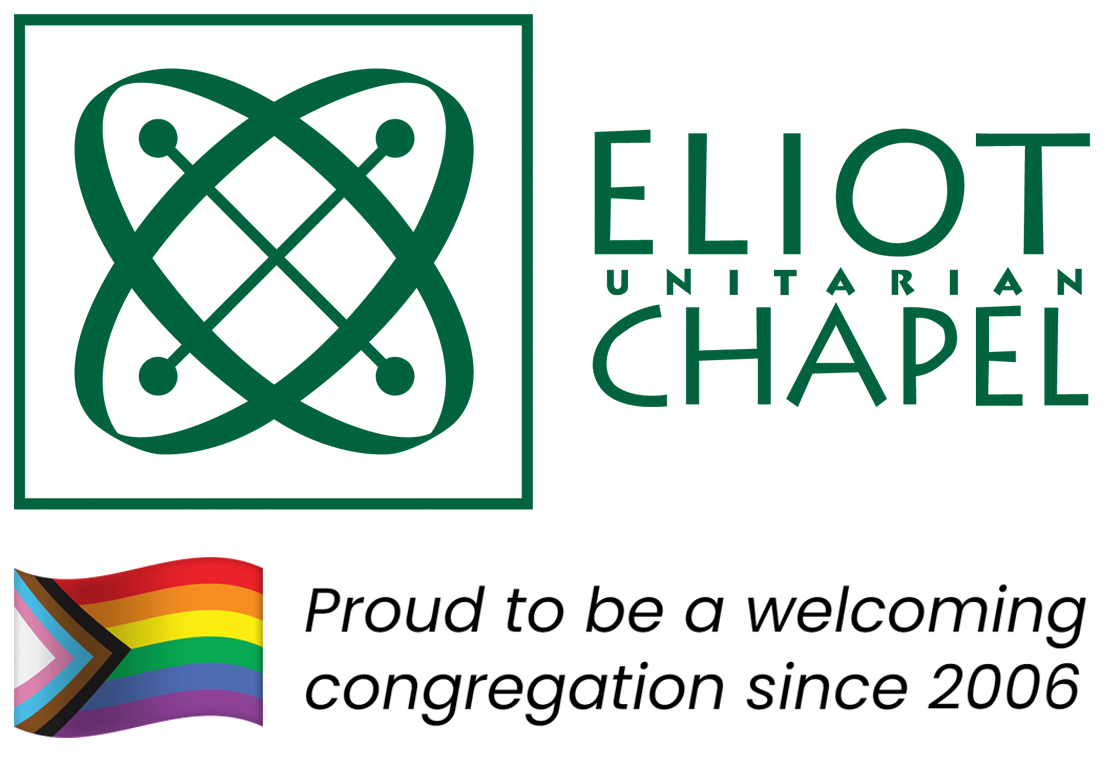Sanctuary Tapestry: This wall hanging hangs in the sanctuary and was created for our 50th year as a congregation. Each color block represents a decade of our history. From the bottom hang pennies to represent each year and woven in are wishes. Welcome!
Eliot Chapel's History
prepared by Amy Stark with a later addition by Rev. Krista Taves
Land Acknowledgement: Before we travel through our church’s history, it is important to know and acknowledge the ground beneath our feet as a way of honoring and expressing gratitude for the people on this land before us. We acknowledge that we are on the traditional lands of the Illini people, taken from them 26 years before Unitarians formed their first church in St. Louis. As you get to know Eliot, please also familiarize yourself with the culture and history of Missouri’s indigenous people, including but not limited to the tribes of the Illini Confederation, the Otoes, and the Missouria (also known as Niutachi [noo-TAH-chi]).
I: BEGINNINGS
William Greenleaf Eliot had just graduated from Harvard Divinity School at the age of 23 when he was persuaded to come to the frontier town of St. Louis to organize a Unitarian Church. Eliot founded the Church of the Messiah in 1835, the first Unitarian church west of the Mississippi. It's important to remember that the Church of the Messiah was Christian with the Unitarian Christian meaning – they did not see Jesus as God, but they were still Christian.
In the mid-1800s, some Unitarians began to question if you had to be Christian to be Unitarian. William Greenleaf Eliot was adamant that you could not be Unitarian if you were not Christian. Those who disagreed with him left and started a new church in 1868, called the Unity Church of St. Louis. This church was open to Christian and non-Christian alike. During the Depression, they came back together as the First Unitarian Church of St. Louis.
Unitarianism in the mid 1800’s created so many of the central institutions in our city. With members of Church of the Messiah congregation, Eliot founded Washington University in 1853; he was its first President and third Chancellor. Besides the University, Unitarians in St. Louis founded many other institutions, including the St. Louis Public Schools, the Art Museum, Mission Free School, South Side Day Nursery, Social Health Association, and the St. Louis Urban League. Despite being central to public institutions, Eliot did not publicly renounce slavery during his tenure.
In 1953, five couples who lived in west county and traveled to First Unitarian of St. Louis each Sunday for services, were asked by the First U. minister to form a family forum program in the suburbs. Due to the population boom and growth, First Church foresaw the need to serve many more Unitarians closer to their homes and perhaps the need for a second church. The demand was high for the forum, so they added church services too, relying on the First U. minister to do an early service with them and rush back to do First Church’s service after. Over the first few years, they met in homes, a dance studio, and the Kirkwood YMCA. In 1955, they adopted the name Eliot Chapel and called their first minister. While the success of Eliot’s start is a credit to those who put in the time and treasure, we must also acknowledge that our church followed the path of white flight out of the city, and we have been intentional in recent years to name this history.

1962 groundbreaking of the religious education wing
II: BECOMING A CHURCH
In 1961, Grace Episcopal Church sold its historic building to Eliot for $25,000, the value of the land. The Religious Education program was still being held at the YMCA down the street. The first priority for the new congregation was space for RE. The first addition, which added eight classrooms, was completed in 1963. After moving into the RE wing, the Eliot Chapel Nursery School was organized by the Women's Alliance in 1963. Eliot Chapel Nursery School is still in operation today inside our building. The 60s brought not just the new church, but a growing call for civil rights in our nation. Many Eliot members joined the movement, others felt less sure of their participation.
In 1969, Webster Kitchell was called as Eliot’s lead minister. His ministry moved us through the end of the turbulent '60s as major cultural shifts occurred and we found our way toward justice issues that concerned us.
One of those efforts came before abortion was legalized: Eliot Chapel became home to the Clergy Crisis Pregnancy Counseling Service, which provided counseling and, when requested, referrals for out-of-state abortions.
In 1967, a major renovation of the sanctuary was undertaken, and to further develop and expand the life of the church, John Robinson was called as the settled minister, in 1973.

The 1984 Bread Service; the 1977 Madrigal cast
Eliot continued to grow and change. We established many traditions, such as the Thanksgiving Bread service and our annual Elizabethan Madrigal Dinner. Robinson seemed to provide a nice balance between our Judeo-Christian traditions and roots and Humanist principles; however, we often did not see ourselves as part of the larger Unitarian Universalist Association and stayed insular in many ways.
In 1977, disaster struck. Fire gutted the religious education wing, the sanctuary was badly smoke damaged, and all the windows on the south side were cracked by the heat. Two days after the fire, the service was held on the steps of the church. The sanctuary was cleaned up for the next Sunday's service, which was Easter. While repairs were made, plans were also made to add to the building again. To quote James Durbin in a presentation made at the Annual Congregational Dinner one month after the fire, "Eliot Chapel is not brick and mortar; it is people and what they do." The spirit of Eliot was not deterred, and the church seemed to find a deeper sense of community.

"Eliot Chapel is not brick and mortar; it is people and what they do."
III: IDENTITY, TRADITIONS
In the 1980’s rituals and traditions started, grew, and changed. Eliot added an annual Seder dinner and flower communion Sunday. We began an intern minister program, adopted our sister church in Transylvania, started a scholarship fund, and helped establish a new Unitarian congregation– Emerson Unitarian Universalist Chapel.

Traditions begun – Seder Dinner and Flower Communion – and ties forged with our partner church in the last century remain strong.
Our members prepared food at a women's shelter and for AIDS patients and participated in work parties to do home repairs for those in need locally. Eliot Chapel hosted St. Louis’ first chapter of Parents and Friends of Lesbians and Gays (PFLAG).
Toward the end of the decade in 1986, the spire that exists was installed, especially designed to replace the traditional cross. The new design appears globe like and represents the four cardinal directions, spinning high above us like a beacon to our tradition and values.

In 1992, we expanded again, adding more classrooms and enlarging our kitchen and fellowship hall. With our added space, we were able to participate in the St. Louis Room at the Inn program, providing dinner and shelter to homeless families every Thursday night. We added more family activities and the arts and music continued to flourish at Eliot. There was a Bluegrass group, regular eclectic coffeehouse evenings, and an occasional pick-up orchestra.
In 1994, with our one service at capacity, we added a second service with its own choir and religious education classes. It seemed we would just keep growing and growing.
IV: WELCOMES, GROWTH PAINS, GOODBYES
In the fall of 1999, our lead minister John Robinson, who had been with us 27 years, announced his retirement. A few ministers carried us through until a search called Rev. Daniel O'Connell, as Lead Minister, and Bonnie Vegiard, as Program Minister, in April 2002. They continued to bring in more families and we were eventually around 500 members.
In 2003, Eliot became the first UUA certified Welcoming Congregation in the St. Louis area, moving us to inclusivity of bisexual, gay, lesbian, and transgender people.
In March 2004, our Lead Minister conducted the first public gay wedding in the Midwest, and later filed the marriage at the county court house. Unfortunately, not all in the congregation wanted this and it was a period of understanding what true welcome could mean, though we were not there yet. There was tension among members as well in whether we should be turning out to the community and advocating in these ways.
In 2010, Revs. O’Connell and Vegiard left Eliot amidst turmoil and a period of church conflict. Trying to move from a pastoral size church to a large church left the congregation uncertain as to how to handle the demands of governance, while still caring for one another and serving the community. The division and unhealthy dynamics that developed left Eliot with some healing to do and reflections on creating a healthier covenant, as goodbyes were said to a significant ministry.
V: A NEW ERA, EMERGING JUSTICE, AND A PANDEMIC
After three years of interim ministry, much discernment about mistakes made, and imagining a new more justice-oriented future, Eliot called Rev. Barbara H. Gadon and formed a new covenant and vision for the church. Rev. Gadon accepted the call and began her role as Lead Minister in August 2013.
After the killing of Mike Brown, just one year after Barbara was called, our church had some soul searching to do to become more socially engaged in our community and to stand in partnership with the St. Louis community in decentering whiteness and creating justice. Our weekly Black Lives Matter vigils began, and we partnered with many organizations for voting rights, justice initiatives, and racial reconciliation.

In 2016, we purchased the house next door to Eliot with a new vision and blueprint for how to use our space. We dreamed of something new and thought about our budget as more of a moral document.
A second Eliot fire occurred in December 2019, partially closing us out of portions of our building, and creating many inconveniences. Just as we considered how to reopen these portions and clean the church, March of 2020 brought us the COVID-19 pandemic and things turned upside down once again.
As we know, life went online and so did Eliot. Staff, church members, and friends learned a whole new way to do church. Anxieties and isolation set in, even with the best efforts, but we entered the next phase of relearning what church and what Eliot could be. Rev. Krista Taves was added to the staff as our Minister for Congregational Life.
In Spring 2023, Rev Barbara announced her retirement effective in June at the end of the church year. We began the reflection process in the search for a new lead minister.
Our interim minister Rev. Doug Wadkins arrived at Eliot in August 2023 and, in addition to outstanding preaching, engaged with us in interim tasks, which include reconnecting with our history, celebrating our accomplishments, reconsidering our mission and vision, governance and staffing assessments, and much more. Rev. Doug’s service to us concluded as the Search Committee focused on calling the Rev. Krista Taves as our next settled minister.
At a Congregational Meeting held March 3, 2024, the vote to call Rev. Krista was 98%, an unusually high percentage for a minister known to a congregation. Rev. Krista, with many tears of joy throughout the sanctuary, accepted the Call. Her installation as Lead minister of Eliot Unitarian Chapel occurred on October 27, 2024.
We now look forward to a period of stable leadership, without worldwide pandemics, and welcome Rev. Krista’s challenge to become the congregation we can be.
How will your journey add to the History of Eliot Chapel?




